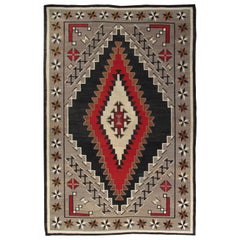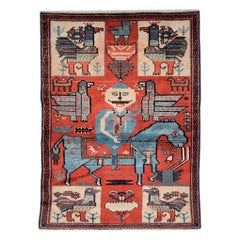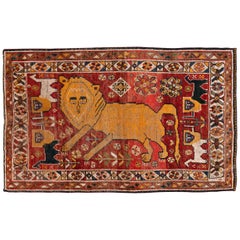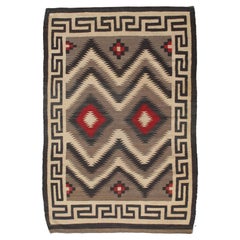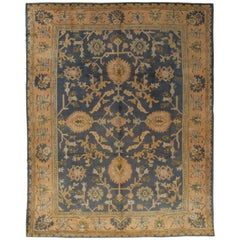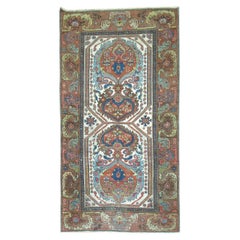Woven Rugs
to
314
524
112
773
480
5
226
94
33
3
2
2
2
1
1
1
2
129
642
485
206
241
83
3
8
17
11
12
14
12
11
2
2
1,254
1,161
311
129
111
905
576
439
389
304
1,258
908
1,082
298
91
24
2
2
Technique: Woven
Large Antique Eye Dazzler Navajo Carpet, Handmade, Wool, Beige, Tan, Gray & Red
Located in Port Washington, NY
Navajo rugs and blankets are textiles produced by Navajo people of the four corners area of the United States. Navajo textiles are highly rega...
Category
Late 19th Century North American Navajo Antique Woven Rugs
Materials
Wool
$21,599 Sale Price
20% Off
Midcentury Handmade Persian Pictorial Folk Rug in Red and Blue-Grey
Located in New York, NY
A vintage Persian Hamadan rug handmade during the mid-20th century with a pictorial depiction of what seems to be a historical figure on his horse surrounded by 4 large peacocks and ...
Category
Mid-20th Century Persian Folk Art Woven Rugs
Materials
Wool
Distressed Persian Handmade Tribal Rug in Deep Red, Orange, and Ivory
Located in New York, NY
An antique Persian Gabbeh tribal rug handmade by the nomadic Qashqai tribe in South Persian during the early 20th century. One large orange folksy lion prances over the deep red fiel...
Category
Early 20th Century Persian Tribal Woven Rugs
Materials
Wool
Vintage Navajo Carpet, Oriental Rug, Handmade Wool Rug, Red, Black, Ivory, Bold
Located in Port Washington, NY
Navajo rugs and blankets are textiles produced by Navajo people of the Four Corners area of the United States. Navajo textiles are highly regarded and have been sought after as trade items for over 150 years. Commercial production of handwoven blankets and rugs has been an important element of the Navajo economy. As one expert expresses it, "Classic Navajo serapes...
Category
Early 20th Century American Navajo Woven Rugs
Materials
Wool
$7,999 Sale Price
20% Off
Antique Oushak Carpet, Handmade Oriental Rug Made in Turkey, Peach, Blue, Ivory
Located in Port Washington, NY
West Anatolia is one of the largest weaving regions in Turkey. Since the 15th century, Turkish rugs have always been on top of the list for having fine oriental rugs.
Oushak rugs su...
Category
Early 20th Century Persian Oushak Woven Rugs
Materials
Wool
$8,000 Sale Price
20% Off
Persian Malayer Rug
Located in New York, NY
One-of-a-kind early-20th century decorative Malayer rug
Measures: 3'7'' x 6'4''.
Category
Early 20th Century Persian Rustic Woven Rugs
Materials
Wool
$3,750
Zabihi Collection Pale Vintage Turkish Oushak Wide Runner
Located in New York, NY
A vintage Turkish oushak neutral color gallery rug
Measures: 4'8'' x 12'4''.
Category
Mid-20th Century Turkish Country Woven Rugs
Materials
Wool
Antique Navajo Blanket "Eagle" Design Oriental Rug Fine German Town Wool Neutral
Located in Port Washington, NY
Navajo rugs and blankets are textiles produced by Navajo people of the four corners area of the United States. Navajo textiles are highly regarded and have been sought after as trade items for over 150 years. Commercial production of handwoven blankets and rugs has been an important element of the Navajo economy. As one expert expresses it, "Classic Navajo serapes...
Category
Early 19th Century American Navajo Antique Woven Rugs
Materials
Wool
$9,749 Sale Price
25% Off
Antique Navajo Carpet, Folk Rug, Handmade Wool, Beige, Gray, Blood Orange
Located in Port Washington, NY
Navajo rugs and blankets are textiles produced by Navajo people of the four corners area of the United States. Navajo textiles are highly regarded and ...
Category
Mid-20th Century North American Navajo Woven Rugs
Materials
Wool
$12,000 Sale Price
24% Off
Skinny Vintage American Hooked Runner
Located in New York, NY
A skinny mid 20th century American hooked runner with an all-over design
Measures: 1'6'' x 11'7''.
Category
Mid-20th Century American Country Woven Rugs
Materials
Jute
American Stained Glass Hooked Throw Rug
Located in New York, NY
A handmade decorative American hooked scatter size rug from the middle of the 20th century
Measures: 2'2" x 4'4''.
Category
Mid-20th Century American Country Woven Rugs
Materials
Wool, Jute
Vintage Turkish Anatolian Pictorial Rug
Located in New York, NY
A vintage Turkish Anatolian pictorial rug from the mid-20th century. A self-taught artist has depicted six buildings and one smokestack in a co...
Category
Mid-20th Century Turkish Folk Art Woven Rugs
Materials
Wool
$2,500 Sale Price
20% Off
Zabihi Collection Pictorial Dog Animal Antique Karabagh Rug
Located in New York, NY
A pictorial rug depicting a dog floating around different humans, animals, and figures on a red ground.
3'9'' x 6'2''
Category
Early 20th Century Caucasian Folk Art Woven Rugs
Materials
Wool
Kilim Rug Caucasian
Located in Antwerp, BE
A beautiful old tribal Caucasian flat-weave. Weave characteristic geometrical motifs, Caucasian Kilim rug. With excellent wool and highly saturated natural dyes, this rug is a great ...
Category
20th Century Caucasian Folk Art Woven Rugs
Materials
Wool
$963 Sale Price
57% Off
Hand-Knotted Wool Rug in Natural White and Sea Green, Modern Geometric Design
By JAIPUR RUGS
Located in Milano, IT
This 6' x 9' Jaipur hand-knotted wool rug, in natural white and sea green, brings a fresh, modern touch to any space. Its geometric design adds visual interest while maintaining a mi...
Category
21st Century and Contemporary Indian Modern Woven Rugs
Materials
Wool
Vintage Oushak Carpet, Handmade Oriental Rug, Pale Caramel, Coral Taupe, Gray
Located in Port Washington, NY
West Anatolia is one of the largest weaving regions in Turkey. Since the 15th century, Turkish rugs have always been on top of the list for having Fine oriental rugs. Measure: 5'3" x...
Category
Early 20th Century Turkish Oushak Woven Rugs
Materials
Wool
$3,499 Sale Price
30% Off
Ararat Rugs Bidjar Rug - 19th Century Design Persian Revival Carpet Natural Dyed
By Ararat Rugs
Located in Tokyo, JP
This is a Bidjar rug designed in the 19th century from the Bidjar region, also known as Bijar, which is a region in northwestern Iran known for producing some of the finest and most ...
Category
21st Century and Contemporary Turkish Revival Woven Rugs
Materials
Wool, Natural Fiber, Organic Material
George Edouard Tremblay Folk Art Hooked Rug, Mat or Tapestry of an Autumn Scene
Located in Hamilton, Ontario
This framed hooked rug or mat was done by the well known George Edouard Tremblay of Quebec Canada in approximately 1940 in his period Folk Art style. The rug or mat is done with wool...
Category
Mid-20th Century Canadian Folk Art Woven Rugs
Materials
Wool, Burlap, Pine
Antique Persian Heriz Carpet Handmade Wool Oriental Rug, Rust, Navy
Located in Port Washington, NY
Heriz carpets are the staple of the furnishing market and remain the most popular of all NW Persian carpets. They were produced for the rapidly growing US market in the late 19th-ear...
Category
Late 19th Century Persian Heriz Serapi Antique Woven Rugs
Materials
Wool
$23,199 Sale Price
20% Off
Maximalist Mosaic Surf Green & Surf Green 240X360 cm Handknotted Rug
By JAIPUR RUGS
Located in Milano, IT
This hand-knotted rug, a captivating creation from the Inde Rose collection by Vinita Chaitanya, is a maximalist symphony of shapes, prints, and textures. Inspired by the arches of J...
Category
21st Century and Contemporary Indian Tribal Woven Rugs
Materials
Silk
George Edouard Tremblay Folk Art Hooked Rug, Mat or Tapestry of a Winter Scene
Located in Hamilton, Ontario
This framed hooked rug or mat was done by the well known George Edouard Tremblay of Quebec Canada in approximately 1940 in his period Folk Art style. The rug or mat is done with wool...
Category
Mid-20th Century Canadian Folk Art Woven Rugs
Materials
Wool, Burlap, Pine
Antique Oushak Carpet, Handmade Oriental Rug, Pale Blue Green, Yellow, Coral Rug
Located in Port Washington, NY
West Anatolia is one of the largest weaving regions in Turkey. Since the 15th century, Turkish rugs have always been on top of the list for having fine oriental rugs.
Oushak rugs su...
Category
Late 19th Century Turkish Oushak Antique Woven Rugs
Materials
Wool
$22,499 Sale Price
25% Off
Antique Persian Sultanabad Carpet Green, Coral-Red, Light Blue, Gold and Ivory
Located in Port Washington, NY
In 1883, Ziegler and Co., of Manchester, England, established a Persian carpet manufacture in Sultanabad, Iran, employing designers from major Western department stores, like B. Altm...
Category
19th Century Persian Sultanabad Antique Woven Rugs
Materials
Wool
$28,799 Sale Price
20% Off
Antique Oushak Carpet, Oriental Rug, Handmade Ivory, Muted Shrimp, Soft Saffron
Located in Port Washington, NY
West Anatolia is one of the largest weaving regions in Turkey. Since the 15th century, Turkish rugs have always been on top of the list for having fine oriental rugs.
Oushak rugs s...
Category
19th Century Turkish Oushak Antique Woven Rugs
Materials
Wool
$60,799 Sale Price
20% Off
Vintage Moroccan Modernist Wool Berber Rug
Located in Milan, IT
Many French carpet designers of the mid-20th century were commissioning their weavings in Morocco, which at the time was a French colony, in that they could obtain beautiful pile car...
Category
1950s Moroccan Art Deco Vintage Woven Rugs
Materials
Wool
Antique Sarkoy Kilim Rug, Western Anatolian Turkish Carpet, Balkan Style Unique
Located in Tokyo, JP
This is an Antique & Unique Sarkoy (Sharkoy or Şarköy) Kilim rug from Western Turkey with a rare and beautiful color composition.
Sarkoy kilims are very finely woven in slitweave in...
Category
Late 20th Century Turkish Kilim Woven Rugs
Materials
Wool, Natural Fiber, Organic Material
George Edouard Tremblay Folk Art Hooked Rug, Mat or Tapestry of a Winter Scene
Located in Hamilton, Ontario
This framed hooked rug or mat was done by the well known George Edouard Tremblay of Quebec Canada in approximately 1940 in his period Folk Art style. The rug or mat is done with wool...
Category
Mid-20th Century Canadian Folk Art Woven Rugs
Materials
Wool, Burlap, Pine
Early and Unusual Loop-Pile Beni Ouarain Moroccan Berber Rug
Located in Milan, IT
The Beni Ouarain confederation is composed of seventeen tribes inhabiting the high mountain region of the northeastern Middle Atlas. Their rugs differ from other Berber weavings in t...
Category
1920s Moroccan Tribal Vintage Woven Rugs
Materials
Wool
New Manisa Fine Handwoven Modern Kilim West Anatolian Rug Turkish Wool Carpet
Located in Tokyo, JP
This is a Western Anatolian Modern 'New' Fine Kilim from the Manisa region with a rare and beautiful color composition.
This kilim is woven according to traditional kilim technique...
Category
2010s Turkish Kilim Woven Rugs
Materials
Wool, Natural Fiber
George Edouard Tremblay Folk Art Hooked Rug, Mat or Tapestry of a Winter Scene
Located in Hamilton, Ontario
This framed hooked rug or mat was done by the well known George Edouard Tremblay of Quebec Canada in approximately 1940 in his period Folk Art style. The rug or mat is done with wool...
Category
Mid-20th Century Canadian Folk Art Woven Rugs
Materials
Wool, Burlap, Pine
Antique Kazak Runner, Handmade Oriental Rug, Red, Blue, Yellow, Off-White, Green
Located in Port Washington, NY
Very unusual design, Kazak rugs are among the most sought after Caucasian rugs. This Kazak is a great example of a 19th century collectible piece. Measures: 3'3" x 6'6".
Category
Late 19th Century Russian Kazak Antique Woven Rugs
Materials
Wool
$2,399 Sale Price
20% Off
Moroccan Vintage Beni Ouarain Rug North Africa
Located in North Hollywood, CA
Moroccan vintage Berber rug from the Beni Ouarain tribes. Lush white and black organic wool rug with geometrical lozenges designs. From the Middle Atlas Mountains, circa 1950s, North...
Category
1950s Moroccan Tribal Vintage Woven Rugs
Materials
Wool
Vintage Turkish Tulu Rug
Located in New York, NY
A vintage Turkish Tulu rug from the mid-20th century.
Category
Mid-20th Century Turkish Minimalist Woven Rugs
Materials
Angora
$1,100 Sale Price
20% Off
Vintage Turkish Anatolian Carpet
Located in New York, NY
A vintage Turkish Anatolian carpet from the mid-20th century.
Category
Mid-20th Century Turkish Tribal Woven Rugs
Materials
Wool
Antique Persian Serapi Carpet, Handmade, Oriental Rug, Rust, Ivory, Light Blue
Located in Port Washington, NY
Antique Serapi carpets are one of the most sought after rugs particularly in America and England for many years. Antique Serapi rugs are a major draw particularly in big city America...
Category
Late 19th Century Persian Serapi Antique Woven Rugs
Materials
Wool
$36,799 Sale Price
20% Off
Antique Persian Serapi Carpet, Handmade Wool Oriental Rug, Rust, Ivory, Lit Blue
Located in Port Washington, NY
Antique Serapi carpets are one of the most sought after rugs particularly in America and England for many years. Antique Serapi rugs are a major draw particularly in big city America...
Category
Early 20th Century Persian Serapi Woven Rugs
Materials
Wool
$20,799 Sale Price
20% Off
Contemporary Handmade Turkish Folk Rug With A Distressed Appeal In Turquoise
Located in New York, NY
A vintage Turkish Sparta rug that has been overdyed teal with hand-knotted raised piles to form the 'pseudo' medallion, spandrels, and border of this modern folk piece.
Category
21st Century and Contemporary Turkish Modern Woven Rugs
Materials
Wool
$2,000 Sale Price
20% Off
1960s Moroccan Vintage Tribal African Rug
Located in North Hollywood, CA
Moroccan authentic vintage tribal rug handwoven by Berber Moroccan women using organic lamb wo and organic dye.Vintage Berber rug from the Taznakht tribe in south eastern Morocco. Ra...
Category
1960s Moroccan Tribal Vintage Woven Rugs
Materials
Wool
American 19th Century Hooked Rug Depicting a Dalmatian
Located in Hudson, NY
Hooked and shirred hearth rug, New England, circa 1850s in wool, cotton and linen. This dramatic folk art piece is in excellent condition.
Depicting a recu...
Category
1850s Folk Art Antique Woven Rugs
Materials
Wool, Cotton, Linen
Moroccan Flat-Weave Vintage Rug
Located in North Hollywood, CA
Vintage Moroccan flat-weave stripes Kilim rug.Large size blanket vintage Moroccan rug, handwoven by Berber women in Morocco for their own use.This rug ...
Category
Mid-20th Century Moroccan Folk Art Woven Rugs
Materials
Wool
Rare and Unusual Mid-Century Modern Beni Ouarain Wool Berber Rug
Located in Milan, IT
The Beni Ouarain confederation is composed of seventeen tribes inhabiting the high mountain region of the northeastern Middle Atlas. Their rugs differ from other Berber weavings in t...
Category
1940s Moroccan Mid-Century Modern Vintage Woven Rugs
Materials
Wool
Vintage Turkish Tulu Rug
Located in New York, NY
A vintage Tulu Turkish rug from the mid-20th century. A wide plain saturated marsala colored border with a beige open field. No ditzy ornamentation. Totally graphic with a very long ...
Category
Mid-20th Century Turkish Folk Art Woven Rugs
Materials
Wool
$1,900 Sale Price
20% Off
Supernova Shag Rug with Abstract Design, circa 1970
Located in Van Nuys, CA
Swedish shag wool area rug with an abstract Supernova design resembling a sun featuring various shades of browns and burnt orange. An excellent colorful rug to accent your room with ...
Category
1970s Swedish Post-Modern Vintage Woven Rugs
Materials
Textile
$1,290 Sale Price
40% Off
Palace-Size Antique Oushak Carpet, Turkish Handmade Oriental Rug Gray Blue Coral
Located in Port Washington, NY
West Anatolia is one of the largest weaving regions in Turkey. Since the 15th century, Turkish rugs have always been on top of the list for having fine oriental rugs.
Oushak rugs su...
Category
19th Century Turkish Oushak Antique Woven Rugs
Materials
Wool
Castilian Las Alturas Edit Rug by HENZEL STUDIO
Located in Geneve, CH
Castilian Las Alturas Edit Rug by HENZEL STUDIO
Dimensions: W 139.7 x L 220.98 cm.
Materials: Wool, Mohair & Silk.
Calle Henzel stands as a trailblazer in the realm of organic, free...
Category
2010s Swedish Post-Modern Woven Rugs
Materials
Wool, Silk, Mohair
$6,418 / item
Silk Moroccan Boho-Chic Flatweave Rug In A Slate Blue Shade
Located in New York, NY
A vintage Moroccan Folk Kilim flatweave from the late 20th century. Slate blue, yellow, red, black, and white are among the hues on this pileless flat Moroccan tribal carpet-textile ...
Category
Late 20th Century Moroccan Bohemian Woven Rugs
Materials
Silk
$2,100 Sale Price
20% Off
Contemporary Handmade Turkish Flatweave Patchwork Rug In White
Located in New York, NY
A modern Turkish Kilim from the 21st century. The rug consists of a vintage hemp Kilim as the white background and raised patches to form the design. No borders, but a finely abrashe...
Category
21st Century and Contemporary Turkish Folk Art Woven Rugs
Materials
Wool, Hemp
$1,900 Sale Price
20% Off
Ararat Rugs Mamluk Wagireh Rug with Geometric Design Revival Carpet Natural Dyed
By Ararat Rugs
Located in Tokyo, JP
This geometric lattice pattern rug has the impression that it is only part of a larger scheme designed 15th-century rug from the Mamluk era, Cairo region, Eygpt. These designs have o...
Category
21st Century and Contemporary Turkish Revival Woven Rugs
Materials
Wool, Organic Material, Natural Fiber
Antique Antalya Dosemealti Rug Southern Turkish Carpet
Located in Tokyo, JP
This is an antique Dosemealti Rug from Southern Anatolia, the Antalya region with a large border, geometric floral pattern ground, good condition, and b...
Category
Early 20th Century Turkish Oushak Woven Rugs
Materials
Wool, Natural Fiber, Organic Material
$3,600 Sale Price
20% Off
Antique Aksaray Kilim Rug Wool Old Central Anatolian Handwoven Turkish Carpet
Located in Tokyo, JP
This is Central Anatolian Antique Kilim from the Aksaray region with a rare and beautiful color composition.
The beauty of the dyeing, the quality of the wool (thread), the splendor...
Category
Early 20th Century Turkish Kilim Woven Rugs
Materials
Wool, Natural Fiber
Antique Mucur 'Mudjar / Mujur' Prayer Rug, Turkish Central Anatolian Carpet
Located in Tokyo, JP
This is an antique Mucur Rug from Central Anatolia, the Kirsehir region with a floral pattern, good condition, and beautiful color composition.
The town of Mudjar (or Mucur) is a...
Category
Early 20th Century Turkish Oushak Woven Rugs
Materials
Wool, Organic Material, Natural Fiber
Fine Large and Palatial Persian Nain Hand-Knotted Wool and Silk Pile Area Rug
Located in Los Angeles, CA
A Palatial Persian Nain hand-knotted wool and silk Pile area rug. The very large and impressive vibrant and colorful medallion carpet with red-burgundy, ivory-beige, blue-Celeste and...
Category
Late 20th Century Persian Islamic Woven Rugs
Materials
Wool, Silk
$59,850 Sale Price
39% Off
Antique Persian Kerman Carpet
Located in Port Washington, NY
Antique Kerman carpet, 12 x 18'10"
This master crafted Persian Laver Kerman carpet exemplifies the profound understanding of the artistic principles of balance and harmony that ma...
Category
Early 20th Century Persian Woven Rugs
Materials
Wool
$25,599 Sale Price
36% Off
Vintage Native American Navajo Rug in a Geometric Pattern in Earth Tone Colors
Located in Barrington, IL
A beautiful example of mid-20th century Native American textile artistry, this vintage Navajo rug features a finely handwoven geometric pattern rendered in an inviting palette of ear...
Category
Mid-20th Century American Woven Rugs
Materials
Wool, Cotton
$900 Sale Price
25% Off
Antique Oushak Carpet, Handmade Turkish Oriental Rug, Beige, Taupe, Soft Salmon
Located in Port Washington, NY
West Anatolia is one of the largest weaving regions in Turkey. Since the 15th century, Turkish rugs have always been on top of the list for having fine oriental rugs.
Oushak rugs su...
Category
Late 19th Century Turkish Oushak Antique Woven Rugs
Materials
Wool
$71,999 Sale Price
20% Off
Round Antique American Hooked Rug. 2 ft 8 in x 2 ft 8 in
Located in New York, NY
Beautiful small antique floral round American Hooked rug, country of origin: America, date circa 1900. Size: 2 ft 8 in x 2 ft 8 in (0.81 m x 0.81 m)
This antique rug was made in A...
Category
Early 20th Century American Folk Art Woven Rugs
Materials
Wool
Rare and Unusual Antique Uzbek Geometric Julkhyr Rug
Located in Milan, IT
Julkhyrs are the long-piled rugs of the Uzbeks of central Asia and are representative of an ancient weaving tradition, when carpets were woven by the people living in the freezing hi...
Category
Early 20th Century Uzbek Tribal Woven Rugs
Materials
Wool
Old Tekke Bukhara Turkmen Carpet, Cental Asian Turkoman Rug RareTurkmenistan
Located in Tokyo, JP
This is a Central Asian Old Tekke Bukhara Turkmen Carpet from the Turkmenistan Bukhara region with a rare and beautiful color composition, high-quality materials like; wool & dyes.
...
Category
Mid-20th Century Turkmen Oushak Woven Rugs
Materials
Wool, Natural Fiber
Vintage American Hand Hooked Rug in Rooster Pattern in Green, Brown, Khaki
Located in Barrington, IL
This vintage American hand-hooked rug features a striking pictorial depiction of a proud rooster standing tall and crowing—an enduring folk art symbol of rural life and morning vital...
Category
Mid-20th Century American Woven Rugs
Materials
Cotton
$2,000 Sale Price
31% Off
Yeager Night Edit Rug by HENZEL STUDIO
Located in Geneve, CH
Yeager Night Edit Rug by HENZEL STUDIO
Dimensions: W 243.84 x L 299.72 cm.
Materials: Silk.
Calle Henzel stands as a trailblazer in the realm of organic, free-form shaped rugs, with...
Category
2010s Swedish Post-Modern Woven Rugs
Materials
Silk
$12,301 / item
